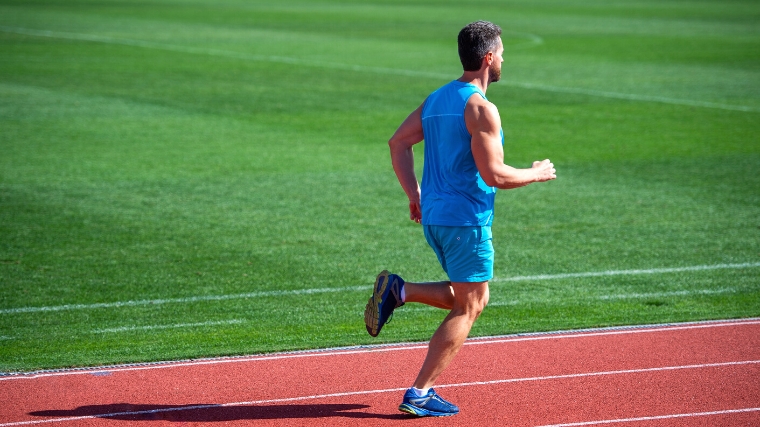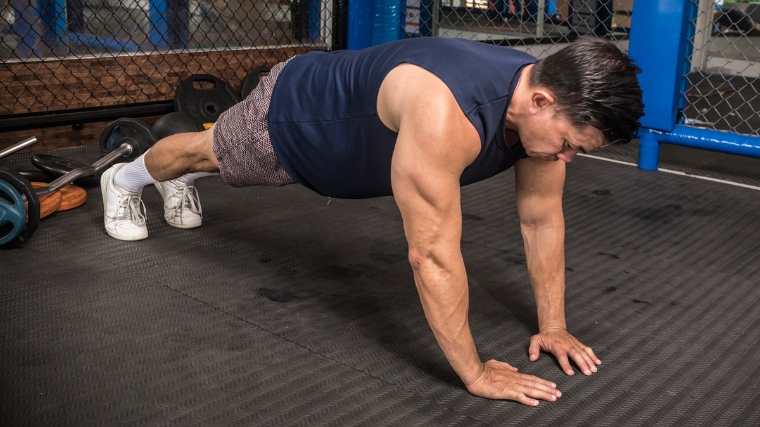Sprinting calls to mind running shoes and high school track and field. Strength sports, on the other hand, tend to evoke thoughts of barbells and clanking weight plates. But you can, in fact, have both.
Sprinting can help make you a better strength athlete. And being a better strength athlete can make you a better sprinter. And while you might be concerned about the interference effect — your sprinting workouts “canceling out” your efforts on the platform — being strategic about your programming can give you the best of both worlds.
Here, you’ll learn all about the best sprint workouts for strength athletes in their respective sports, as well as how (and why) to use them to your advantage.
Best Sprint Workouts for Strength Athletes
- Sprint Workout for Powerlifters
- Sprint Workout for Weightlifters
- Sprint Workout for CrossFitters
- Sprint Workout for Bodybuilders
- Sprint Workout for Strongman Athletes
Sprint Workout for Powerlifters
While this is not the case for every athlete, the archetypal powerlifter hasn’t dusted off a treadmill in years. For powerlifters, it’s all about the big three — the squat, bench press, and deadlift. If a powerlifter does cardio at all, it’s often an afterthought and at a low intensity.
There’s a certain logic to this: high-intensity bouts of high-impact exercise (like sprinting) can interfere with your recovery as a strength athlete. This is especially true if two of your three big lifts are lower-body dominant and if you’re not strategic about your programming.
But if it’s timed correctly, sprinting workouts can be a tremendous asset to powerlifters. After all, when you need to dig deep to grind through that last rep, you’ll want all the short bursts of energy you can get. And you can increase that capacity through sprinting.
The Workout
Program this workout at the end of a squat day. If possible, perform it as a two-a-day workout such that you do your strength workout in the morning and this cardio routine at least six hours later.
Pairing your sprint workout together with a squat day allows you to consolidate your recovery. Your legs already took a beating during your squat-heavy workout. You’ll give them another (literal) run for their money with this sprint workout. Then, your legs will be able to recover from both workouts at once during your benching day and any active rest you might have.
- 2-minute walk or jog
- 15 to 30-second sprint
- Repeat four to 10 times, depending on your experience level.
Sprint Workout for Weightlifters
Weightlifting and sprinting don’t seem like natural allies, but they’ve actually got a lot in common. They’re both about generating a lot of power very quickly. You need to tap into deep wells of energy to move something — either a loaded barbell or your body — as fast as possible.
[Read More: The Best Leg Exercises for Your Next Leg Day]
As a weightlifter, you rely on strong legs, quick power, and excellent technique. For your sprint workouts, you’ll work on maintaining that technical precision across your training. This way, you’ll keep your mind laser-focused on the goal at hand.
The Workout
Always be sure to perform this workout after your primary workout. Barbell work — especially for weightlifters — is tremendously precise and high-intensity. Make sure you’re showing up at your best mentally and physically for your snatches and clean & jerks. Save your sprints for later in the day or after your initial session.
Because weightlifters need to be fast and well-coordinated, you’ll move through some drills during your active recovery periods.
- 60-meter sprint
- 120-meter walk or jog
- 20 high-knee skips (10 per side)
- Repeat four to eight times, depending on your experience level.
Sprint Workout for CrossFitters
As a CrossFitter, a lot of your workouts operate functionally as sprints of one kind or another. Sometimes, you’ll be literally sprinting from point A to point B as a part of your WOD (workout of the day).
Other times, you’ll be moving as quickly and efficiently as possible from your rig to your barbell and back. In most cases, you’re operating under a time crunch where speed is of the essence.
For a CrossFitter, the ability to sprint is a potential part of competition, which is not the case for other strength athletes. But sprint workouts can also help develop those reserves of energy, mental grit, and power that CrossFitters need all across the board.
The Workout
In CrossFit, sprints will sporadically be programmed into WODs on their own accord. Other times, athletes will have to do sled sprints or longer runs with weighted vests. But running is rarely the sole basis of a WOD.
Instead, CrossFitters will typically combine sprinting with other modes of exercise — barbell work, odd object training, or gymnastics-style movements like muscle-ups or toes-to-bar. This workout will take you through a similar variety of exercises to maximize your work capacity and efficiency as a CrossFitter.
For Time:
- 120-meter sprint
- 10 muscle-ups*
- 90-meter sprint
- 10 chest-to-bar pull-ups**
- 60-meter sprint
- 10 sandbag cleans
- 30-meter sprint
* If you can’t perform muscle-ups yet, sub with full dips or bench dips.
** If you can’t perform chest-to-bar pull-ups yet, sub with pull-ups or jumping pull-ups.
Sprint Workout for Bodybuilders
All things being equal, bodybuilders are most comfortable in the gym. But that doesn’t mean that they can never get out and make things happen on the track. Sprinting workouts are renowned for their calorie-burning capacity, which may be important for bodybuilders looking to optimize their body fat percentage.
What’s more, sprints can offer a welcome dose of variety to a bodybuilder’s usual routine. But sprinting has a very high impact on an athlete’s joints. A bodybuilder’s priority with any supplemental training will be to ensure maximum recovery and minimal wear and tear that may take away from their ability to grow high-quality muscle mass.
To make sure that sprinting fits well into your routine, make sure you’re hitting your macros and getting enough calories to sustain the additional strain and energy expenditure of sprinting. The last thing you want to do is compromise the quality of your recovery by adding another burst of high-intensity training to your program.
The Workout
For bodybuilders who may not generally devote a lot of time to cardio, it’ll be important to remember that what your CrossFit buddy considers a jog may be your sprint. Take it at the pace you’re able to access, and you’ll improve from there.
Program your sprint workout(s) in accordance with your chosen training split. Tying your sprint workouts to the end of your leg training may seem counterintuitive at first, but it’ll help you maximize your recovery time for your legs to be recovering from two workouts at once.
By sprinting after your strength training, you’ll use most of your energy on lifting — that’s exactly what you want as a bodybuilder.
- 90-second walk or jog
- 15-second sprint
- 60-second walk or jog
- 30-second sprint
- 90-second walk or jog
- 45-second run
- 2-minute walk or jog
- Repeat three to four times.
Sprint Workout for Strongman Athletes
Strongman athletes are no strangers to conditioning workouts. The high-intensity conditioning it takes to perform an Atlas stone load or truck pull, for example, is intense — to say the least.
Because conditioning under heavy load is most applicable to a strongman’s conditioning needs, these athletes may benefit most from sports-specific types of sprinting. This involves loaded sprints of varying lengths with different odd objects or implements.
The sports-specific nature of loaded sprint workouts takes the training principles of sprinting — producing a lot of force and moving quickly — and applies them to strongman events. You can get a lot of variety here. In doing so, you’ll keep your training intensity high and your chances of boredom low.
The Workout
When you think of sprinting, you might immediately think of running. But this workout is a lot more multi-modal. That helps account for all the different kinds of load a strongman athlete needs to be prepared to take on.
In the cases where these moves are part of the day’s training routine, save this workout for a day with lighter loads. You’ll still be working hard, but using lighter loads will allow you to combine different movements for a higher conditioning impact with less added strain on your body. That way, your sprints won’t eat into your regular training or recovery.
- 30-foot sandbag carry
- 30-foot sled push
- 30-foot sled pull
- Repeat four to six times
Benefits of Sprint Workouts for Strength Athletes
If you’re a strength athlete, sprinting probably isn’t the first thing on your mind when you’re designing your program. But sprinting can give some distinct benefits for athletes whose primary focus is moving a barbell.
Sports-Specific Conditioning
For any athlete, it’s helpful to have a strong baseline of aerobic fitness. Having a set of heart and lungs that can work together efficiently with the rest of your body is helpful for your overall athletic performance and longevity. But there is a different kind of cardio conditioning that helps you more directly on the lifting platform than slow, steady-state cardio.
When you set up for a bench press or prepare to pull a loaded barbell off the ground, your body isn’t going to use the same type of energy it uses to run marathons. It needs a source of energy that is fast, intense, and immediate. That’s the kind of energy system that sprinting develops.
So when you perform quick and dirty sprinting workouts as a strength athlete, you’re developing the ability to call up a big burst of energy really quickly. That’s exactly what you need when you’re about to perform a max snatch attempt or do a heavy squat double.
Increased Work Capacity
Your work capacity refers to the amount of work your body can do in a given period of time. Timed benchmark workouts are a great example of this. Here’s a given rep scheme, load, and exercises. How many times can you repeat it in twelve minutes? In other words, what capacity do you have to push yourself during that time period?
Sprinting helps you build your work capacity so that you can take on higher loads at higher volumes. If you can sprint a few bouts of 100 meters, you’re more likely to be able to eke out more high-quality volume from your squat session. And the better you get at accumulating high-quality volume under heavy load, the stronger you can become.
More Cardio Variety
Variety is not only the spice of life — it’s the crux of all sustainable workout programs. Yes, you need consistency for effective overload and muscle development. But you also don’t want to be jogging that same 20-minute jog every time cardio comes up in your program.
By adding sprinting to your cardio repertoire, you’re building a well-rounded program. This will help you build both your aerobic (steady state) and anaerobic (fast and intense) energy systems.
This will not only add more physical value to your program but mental value, as well. Sprinting might be tough, but it’s also over pretty quickly. This burst of “I didn’t want to, but I did it” can help give your program that boost of mental toughness and variation it might be lacking. This can pay off tremendously in terms of your confidence and cardio fitness.
How to Scale Sprint Workouts
When you scale a workout, you’re modifying it to make it easier or more challenging, depending on your goals or experience levels. If a workout as written is too difficult, you can (and should) scale it to make it more accessible. You can still reap the benefits, and eventually will be able to perform it as written.
If you are already an experienced sprinter or are particularly cardiovascularly fit, you might opt to make certain sprint workouts more challenging. Here are some key tips for modifying a sprint workout to suit your needs.
Start Where You’re At
One person’s jog is another person’s sprint. If you’re sprinting to keep up with your gym buddy’s recovery pace, that’s alright. There’s no standard for what it means to “sprint.” For beginners, aim to gauge your sprints based on effort rather than speed.
A sprint will mean firing on all cylinders, at an eight to 10 level out of 10. The speed you wind up with — and how long you can sustain it — will get better over time. But starting out too fast is a recipe for disaster, especially for the inexperienced.
Pace yourself. If a workout calls for a 30-second sprint, but you cannot sustain a very high-intensity effort for more than 10 seconds, adjust the workout. Either transform your time from 30 to 10 seconds or modulate your effort, pushing at a level six or seven instead of eight or nine for 30 seconds. You can also rest for longer periods of time when necessary.
The goal should be to challenge yourself and complete the workout. Take note of your current paces and abilities to measure your progress over time.
Increase Duration, Then Speed
To get better at sprinting, it’s not all about getting faster right away. Just like with weight training, you need to apply the principles of progressive overload.
Say you know what a challenging but comfortable pace is for a 30-second sprint. To progress, try to maintain that pace for 35 seconds over the course of a few workouts. When you can do that, add five seconds across workouts. Continue at that pace until you can sustain it for 45 to 60 seconds.
Then, drop back down to a 30-second sprint and try to push a bit harder to get faster. Repeat the process to progressively increase your speed.
Of course, there are other methods you can deploy to get faster. Running at an incline and various form drills can also help get you to sprint faster. Developing stronger legs is another key component here — strength training may help quite a bit in this department.
Manipulate Rest Periods
Sprint workouts aren’t all about sprinting itself. Your rest periods also play a crucial role in developing your strength, power, and cardiovascular fitness.
Resting for longer periods of time will be essential when you’re first starting out, so feel free to extend rest periods as needed. Gradually, you can work on putting a cap on your rest periods and cutting them shorter. But generally, aim to breathe as deeply and slowly as you can while recovering. Once you’ve largely caught your breath, start again.
Alternatively, if you need to up the ante, you can make your rest periods shorter. This will challenge you to recover faster between bouts and will bring you a heightened level of cardiovascular fitness and ability to catch your breath.
Add Strength Training
If you’re primarily a strength athlete, sprint workouts are already meant to supplement your barbell exercises. But you can also add components of strength training into your sprint workout itself.
For example, add a round of push-ups between sprints instead of only walking or jogging during your rest period. This will tax your cardiovascular system and challenge you to recover faster while also helping you focus on your entire body.
Sprint for Strength
Sprint workouts for strength athletes are no joke. Strength training on its own can be extremely intense. Adding high-intensity sprint workouts to your routine will definitely increase the demands of your recovery — so make sure you’re getting the rest and fuel you need between workouts.
Program your sprint workouts after your training sessions — ideally, a few hours after — to make sure you’re keeping your emphasis on barbell work. But once you get a routine going, the benefits will be great. You’ll be able to breathe easier, generate more power, and boost your work capacity on the lifting platform. So lace up your running shoes and get going.
Featured Image: Panumas Yanuthai / Shutterstock









